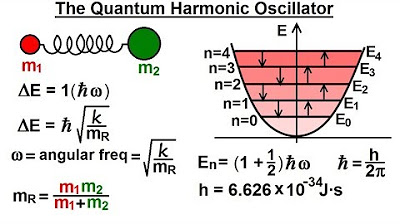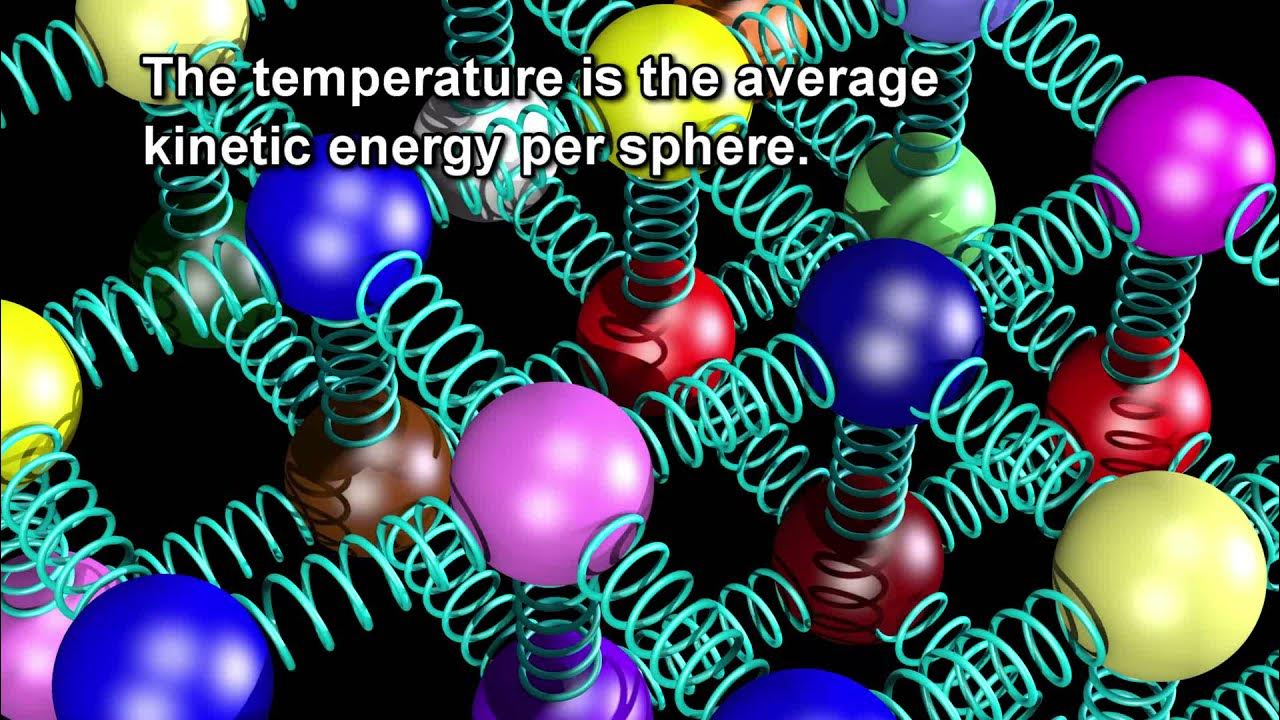CompChem.02.01 The Potential Energy Surface — Preamble to the Basic Force Field Part I
TLDRThis video lecture introduces the concept of the potential energy surface, a fundamental tool in computational chemistry for understanding molecular energetics, reactivity, and equilibria. The potential energy surface is a multidimensional representation where each point corresponds to a unique molecular geometry and its associated energy. The lecturer explains that for a diatomic molecule, the surface is one-dimensional, plotting energy against bond distance. However, for more complex molecules, the surface becomes higher dimensional, typically 3N-6 dimensional, where N is the number of atoms. The challenge lies in visualizing and understanding these high-dimensional surfaces. The lecture discusses methods to simplify this complexity, such as taking slices through the surface at fixed values of certain coordinates, which allows chemists to focus on the energy changes associated with a single degree of freedom or reaction coordinate. The importance of considering the relaxation of other degrees of freedom during a reaction is also highlighted, as it can lead to a more stable, lower-energy state. The lecture concludes with thought-provoking questions about the topology of potential energy surfaces and the difference between using internal molecular coordinates versus fixed spatial coordinates.
Takeaways
- 📚 The potential energy surface (PES) is a conceptual tool used in chemistry to visualize the energy of molecular structures as a function of their geometry.
- 🔍 A PES captures the relationship between molecular geometry and energy, which is crucial for understanding chemical reactivity and equilibria.
- 📈 The simplest representation of a PES is a one-dimensional curve, like that for a diatomic molecule, where energy is plotted against bond distance.
- 🤔 For more complex molecules, the PES is a multidimensional surface, which can be challenging to visualize and requires reducing dimensions for practical analysis.
- 🧩 The dimensionality of a generic PES is 3n-dimensional, where n is the number of atoms, but this can be reduced to 3n - 6 degrees of freedom for most molecules due to translational and rotational invariance.
- ⛓ For diatomic molecules, the PES is 1-dimensional, but for triatomic and larger molecules, it becomes 3n - 6 dimensional, complicating the visualization.
- 🔑 A slice through the PES, holding certain coordinates constant, can simplify the representation to a two-dimensional plot, which is more easily analyzed.
- 🔄 The concept of a reaction coordinate simplifies the PES to a one-dimensional curve that represents the energy changes associated with a single degree of freedom, such as a bond stretch or angle bend.
- ⚖️ In reality, a true reaction coordinate allows for the relaxation of other degrees of freedom, leading to a lower energy path, which is more stable and preferred in nature.
- 📊 Plotting the energy changes while holding all degrees of freedom fixed, except for the reaction coordinate, provides insight into the energy barriers and pathways of chemical reactions.
- 🤔 The topology of a PES defined by internal coordinates is fundamentally different from one defined by fixed spatial coordinates (XYZ), as the former accounts for relative atomic positions and chemical bonds.
Q & A
What is a potential energy surface?
-A potential energy surface is a conceptual construct used in chemistry to represent the energy of a system as a function of its molecular geometry. It helps in understanding energetics, reactivity, and equilibria in chemical reactions.
How does the potential energy change as atoms move closer or further apart in a diatomic molecule?
-In a diatomic molecule, as atoms move from large distances towards each other, the potential energy decreases due to attractive forces until it reaches a minimum. Beyond this point, as the atoms get too close, the energy increases due to repulsive forces.
What is the dimensionality of a generic potential energy surface for a molecule with multiple atoms?
-The dimensionality of a generic potential energy surface is 3N, where N is the number of atoms in the molecule. However, due to translational and rotational invariance, this can be reduced to 3N - 6 degrees of freedom for non-linear molecules.
Why is it common to consider a single dimension on a potential energy surface?
-Considering a single dimension, often referred to as a reaction coordinate, simplifies the analysis of chemical reactions and conformational changes. It allows chemists to focus on the energetic changes associated with a single coordinate that dominates the process.
null
-null
How does the relaxation of other degrees of freedom affect the potential energy surface?
-The relaxation of other degrees of freedom can lower the energy of the system. As one bond is stretched or compressed, other bonds and angles may adjust to minimize the overall energy, leading to a more stable, lower-energy state.
What is the importance of understanding the topology of a potential energy surface?
-The topology of a potential energy surface provides insights into the reactivity of molecules and the pathways available for chemical reactions. It helps predict the stability of different molecular conformations and the energy barriers that must be overcome for reactions to occur.
How does the potential energy surface change when considering a slice through it at a fixed bond angle?
-When considering a slice at a fixed bond angle, the potential energy surface becomes two-dimensional, with one axis representing the bond length between two specific atoms, and the other axis representing the energy. This slice represents all possible geometries at that bond angle.
What is the difference between a fixed and relaxed reaction coordinate?
-A fixed reaction coordinate assumes that all other degrees of freedom, such as bond lengths and angles, remain constant during the reaction. In contrast, a relaxed reaction coordinate allows these other degrees of freedom to adjust, which typically leads to a lower energy state and a more accurate representation of the reaction pathway.
Why is it challenging to visualize a potential energy surface with more than three dimensions?
-Visualizing a potential energy surface with more than three dimensions is challenging because humans cannot perceive more than three spatial dimensions directly. To represent higher-dimensional data, chemists use techniques such as contour plots, color gradients, or dimensionality reduction methods.
What is the significance of the minimum on a potential energy surface?
-The minimum on a potential energy surface corresponds to the most stable configuration of the molecule, often referred to as the equilibrium geometry. Molecules tend to reside in this state as it represents the lowest energy configuration under the given conditions.
How does the potential energy surface concept relate to the study of molecular mechanics and force fields?
-The potential energy surface is fundamental to molecular mechanics and force fields, as it provides a mathematical description of the potential energy of a system based on its geometry. Force fields are models that describe the potential energy surface, allowing for the calculation of forces and the simulation of molecular behavior.
Outlines
🌟 Introduction to Potential Energy Surfaces
This paragraph introduces the concept of potential energy surfaces, which is a key topic in computational chemistry. The potential energy surface captures the idea that each molecular geometry has a unique energy associated with it. By plotting energy as a function of atomic positions, we can create a smooth energy landscape that provides insights into important chemical concepts like reactivity and equilibria. The simplest example is a one-dimensional potential energy surface for a diatomic molecule, where the energy is plotted as a function of the bond distance between the two atoms.
📐 Dimensionality of Potential Energy Surfaces
This paragraph discusses the dimensionality of potential energy surfaces. For a system of n atoms, there are 3n Cartesian coordinates. However, due to translational and rotational invariance, we can reduce the dimensionality to 3n-6 degrees of freedom for a non-linear molecule. This is because we can translate or rotate the molecule without changing its energy. The potential energy surface is then a 3n-6 dimensional hypersurface. But chemists often simplify it further by considering one-dimensional slices through the surface, called reaction coordinates, that correspond to a single geometric coordinate changing while others are held constant.
🎨 Visualizing Potential Energy Surfaces
This paragraph explores the challenge of visualizing high-dimensional potential energy surfaces. A triatomic molecule has a 3-dimensional potential energy surface. We can represent it by plotting in 3D and using color to encode the 4th dimension of energy. But a more intuitive approach is to take 2D slices through the surface at fixed values of certain coordinates. Each slice shows the energy as a function of two bond lengths, while other coordinates are held constant. By analyzing these slices, we can gain insights into how the energy changes as bonds stretch or compress. The challenge is to carefully define and interpret these reduced dimensionality representations.
⛓ Relaxed vs. Constrained Reaction Coordinates
This paragraph distinguishes between relaxed and constrained reaction coordinates. A relaxed reaction coordinate allows all degrees of freedom to adjust to lower the energy during a reaction, while a constrained coordinate holds certain coordinates fixed. The true reaction path involves coordinate relaxation, where bond lengths and angles adjust to stabilize the system as a bond is broken. This leads to a lower energy profile compared to holding other coordinates constant. The exercise asks students to draw the potential energy curve for rotation in n-butane, considering both the relaxed and constrained cases starting from different conformations. It also prompts reflection on how the topology of a potential energy surface defined by internal coordinates differs from one defined by fixed Cartesian coordinates.
Mindmap
Keywords
💡Potential Energy Surface
💡Diatomic Molecule
💡Degrees of Freedom
💡Reaction Coordinate
💡Bond Stretching
💡Topography of PES
💡Molecular Mechanics
💡Force Field
💡Conformational Analysis
💡Relaxation
💡n-Butane Rotation
Highlights
Introduction to the concept of a potential energy surface, a fundamental tool in understanding chemical energetics, reactivity, and equilibria.
Explanation of how potential energy surfaces represent the energy of molecular structures based on atomic positions in space.
Discussion on the smooth change of energy as atoms are moved, leading to a continuous energy landscape.
The one-dimensional potential energy surface example of a diatomic bond stretch, illustrating the relationship between bond distance and energy.
Description of the potential energy surface's minimum point, indicating the most stable configuration of a molecule.
Clarification on the dimensionality of a generic potential energy surface and the concept of degrees of freedom in molecular geometry.
The reduction of dimensionality by considering relative atomic positions rather than absolute Cartesian coordinates.
Introduction of the 3N-6 rule for the number of degrees of freedom in a molecule, excluding linear molecules.
Challenge of visualizing and graphing potential energy surfaces in more than three dimensions.
Use of slicing through the potential energy surface to reduce dimensionality and focus on specific molecular interactions.
The concept of a reaction coordinate as a one-dimensional slice through the potential energy surface, focusing on a single degree of freedom.
Discussion on the importance of allowing other degrees of freedom to relax during a reaction to follow the lowest energy path.
The difference between a fixed reaction coordinate and a relaxed reaction coordinate, and their implications on energy.
The use of color to represent the fourth dimension of energy in a three-dimensional plot of a potential energy surface.
Thought exercise on drawing and comparing the relaxed and non-relaxed rotational reaction coordinate for n-butane.
Consideration of the topological differences between potential energy surfaces defined by internal coordinates versus fixed spatial coordinates.
Encouragement for students to ponder the implications of molecular geometry and energy changes on the topology of potential energy surfaces.
Conclusion of the lecture with a prompt for further thought and discussion on the topic.
Transcripts
Browse More Related Video

1.4 Molecular Orbital Theory | Organic Chemistry

Gravitation (9 of 17) Gravitational PE Far From Earth, the Negative Sign, An Explanation

Calculus Chapter 4 Lecture 36 Surface Area

Physics - Ch 66 Ch 4 Quantum Mechanics: Schrodinger Eqn (39 of 92) What is the Quantum Oscillator?

Molecular Temperature & Degrees of Freedom

4.5 Newman Projections | Organic Chemistry
5.0 / 5 (0 votes)
Thanks for rating: